Chinese Buddhist monks developed block printing around 850, carving their intricate characters and images into the surface of wood blocks to print their scriptures. But it was Johannes Gutenberg’s invention of the printing press, with its movable type in 1440, that made the printed word the standard for mass communication. And once ink hit the paper, it was permanent and static. And the books were put on shelves … some for hundreds of years.
When the book “Understanding Media” came out in the 1960’s, Marshall McLuhan declared that the “medium is the message”. He predicted a “global village” or interconnected world of communication, the next step in the evolution of mass communication. Twenty years later, we had it—the internet.
One of the major changes in our shift from print to online graphics is the capability of motion. And with the infinite competition for attention on the internet and television, content providers have ramped up visuals to keep our attention. A great example of this constant movement is the cable news show format. First we have the anchor talking to us, then the screen splits into two to five other talking heads or a looping reel of the current story, while type “crawls” across the bottom of the screen with “breaking news”, and the chyron box, also called the “lower third” contains the current speaker’s name and title, alternating with other details of the story. If you look closely, even the static chyron box will still have a subtle moving background image. There is nowhere for the eye or brain to rest even for a second. Everything competes for the viewer’s attention.
Studies show the effect of the cacophony of stimuli has reduced the attention span of the average person. A study by Microsoft in 2015 found the average attention span dropped from 12 seconds to 8 seconds in 15 years. They point out the average attention span of a goldfish is 9 seconds. Is this a good thing? And the incessant bombardment may be a marketer’s dream, but is it good design?
In print, the designer works to present clear information that directs the eye and ultimately provoke an action—buy! Today’s innovative motion graphics expands that capability with the use of some overlapping interplay — informative, yet playful typography moving between photos and colorful graphic elements, with overlaid music and sound effects — to keep the eye and brain of the viewer engaged and committed to seeing where the story goes. Text must be in small chunks—something a goldfish can handle.
The key is to use enough movement to hold the viewer’s attention but not to become the story itself, adding positively to the total experience like another character or messenger directing the story. For products directed at younger audiences, the “grunge” look, rough and almost unreadable, with faster cuts, could be exactly right for the message. Industrial and scientific businesses will still present a more professional image and message, but movement is now a necessary and powerful tool to keep the typical visually over-stimulated viewer interested in the message. Pace is critical too. A little too slow and the viewer’s attention easily drifts. It should be fast enough to pull the viewer along the story, but not so fast that they can’t keep up. And the age of the target audience defines a specific pace.
The age of motion has required a lot of specialized learning and new software mastery for designers. After a lifetime working in print, and over a decade in 3D and animation, the evolution for me has been exciting, and it feels like the mesh of my 2D and 3D skillsets and the tools that unlock them, are something I have dreamed of since I was in my 20s. This is an area I have fully embraced, and armed with my 2D, 3D and 4D toolbox, my little one-man studio makes effective marketing videos for clients to share with the global village.
Share this:


11 Responses
Judy
Now I am losing interest!!! I typed a comment, filled in the rest, hit “submit comment” and it came back asking me to submit comment again. Now as a septuagenarian, asking me what I just typed is a challenge! Nice observations of attention-span attention changes though. I totally agree about the bombardment we are constantly exposed to and its effect on us. People need to know it is good to “unplug” regularly…for an hour; for a day; for several days, etc. It is OK to cultivate off-grid time for the good of us all.
Judy
Well Bill, at my age I don’t even TRY to attend to screen bombardment! I just go with what’s in the middle, and the rest eventually falls into place if it is worthy. Your blurb is worthy and yes, I made it to the end! Nice!
bgob1
The older we get, the faster we cut to the chase, Judy.
Gayle
OMG the goldfish video was perfect! Orange lives matter! I feel bombarded when I watch cable news and often when surfing the internet too. So much coming at me! Great explanation of all this and how to best use the technology to enhance the message rather than bury it. 7, 8, 9… sorry that’s all the attention I’ve got for this……
bgob1
It’s quite a challenge.
travis giobbi
What a fun read, very educational. I’ve known some of this data in pieces but it’s kind of jaw dropping when you put them all together. I can’t believe our attention span is one second shorter th
bgob1
Loved your comment. Perfect endin
Elisa Mills
Another riveting read, Bill. I easily made it to the end! Our collective attention spans, or lack thereof, are a tad frightening, though.
bgob1
…and getting shorter. watch.
Don
Great video. Fits the Goldfish’ attention span with a second left to ponder.
To love ones family is joy, to love ones work is added bliss. To love both, ahh, nirvana!
You are blessed and a blessing.
Don
bgob1
I hope you spent that second wisely. Thanks, Don. Right back to you.